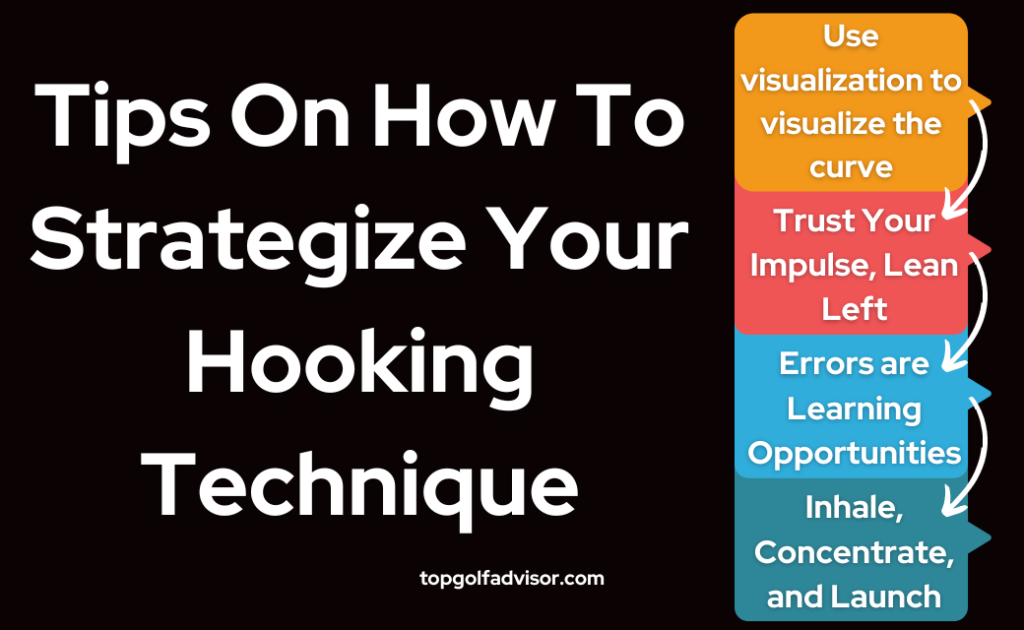Picture this: a frightening row of trees encircling the green, a narrow fairway that doglegs. Gripping the club, your heart thumps. Do you proceed straight and run the risk of being engulfed by the trees? Or are you brave enough to mold the ball? If Not!, it’s time you learn how to hook a golf ball.
A challenge and an exhilarating twist from left to right is provided by the controlled hook. It’s about learning to be defiant and controlling your ball’s trajectory rather than giving in to the demands of the course. It’s like creating a masterwork on the landscape, with every curve of the flight representing a skillful brushstroke.
Also, it’s not all that easy, you have to learn the dynamics and practice as much as you can. Therefore, today’s blog is going to be a fun little trip for all golfers seeking new knowledge to up their game.

How To Hook A Golf Ball – Learning The Hook Mechanics
Three crucial factors influence the hook, a dance between the ball and the club: club face angle, swing route, and grip pressure. Let’s take a closer look at each layer to see how it all fits together to create that seductive bend to the left.
1. Club Face Angle: Curve’s Canvas
Consider your canvas to be the club face. It creates a curved masterpiece on the green when it is closed at contact and slanted slightly to the left. The ball veers left and resists the ball’s natural rightward fade as a result of the club face imparting spin on it during impact.
- Address Position: To ensure a closed club face at impact, position your torso slightly to the left of your target.
- Takeaway: To encourage a natural closing through the swing, begin your swing by getting the clubhead moving within the target line.
- Release: Concentrate on “rolling” your wrists during impact to further close the club face and send the ball spinning to the left.
- See the Curve: Envision schematics that depict a closed club face making contact with the ball, with arrows indicating the spin and subsequent ball trajectory.
2. Swing Path: Intentionally Brushing
Consider the swing route to be your paintbrush. The clubhead swings from inside the desired line to outside upon contact, creating an inside-out swing path that directs the ball down the intended leftward curve.
- Wiping Out for a Hook:
Feel Like You’re Throwing a Frisbee: Swing inside first, then release it on an outside arc to mimic throwing a Frisbee. Allow the club to catch up and close at contact by maintaining a “lag” between your hands and clubhead during the downswing.
3. Grip Force: A Gentle Prod
Grip pressure can add a little leftward bias and gradually affect the club face angle, similar to a gentle prod. You can encourage the club face to shut upon impact by using a tighter grip and applying more pressure with your palms.
- Grasping to Maintain Control:
A tighter grip and proper wrist motions can greatly impact the performance of your hand positioning. Grip pressure is not the only way to get a hook. The secret to consistently making controlled and repeatable curving shots is to master the swing route and club face angle with precise mechanics.
Practice Drills and Techniques
Here are two sure ways to practice drills and techniques to learn how to hook a golf ball the right way.
- Warm-up Drills:
- Wrist rolls and hip turns to loosen up and promote a smooth swing.
- Shadow swings focus on feeling the inside-out swing path and closing the club face.
- Short chipping drills with a closed club face to groove the impact position.
- Progressive Practice:
- Start with hitting balls off a tee with a deliberate focus on the club face angle and swing path.
- Gradually progress to full irons, focusing on maintaining control and accuracy with the hook.
- Practice shaping shots around obstacles on the driving range and course.
How To Hook A Golf Ball With Different Types Of Irons
While swing mechanics are a must for shaping shots, the kind of iron you use also has a slight bearing on the flight of the shot. Let’s examine how several irons may affect your search for the ideal hook:
1. Iron blades:
Skilled players love these sleek beauties because of their limited offset and slender faces. Their combined increased sensitivity to the swing path encourages a closed club face upon impact. Blade irons have strong hooks and crisp ball striking that reward accurate swings, but mishits can be punished due to their harsh nature.
2. Irons for Cavity Backs:
The enlarged sweet spot and enhanced forgiveness of these irons come from a hollowed-out hole behind the clubface. Their greater moment of inertia helps prevent undesired clubface rotation, which makes them less vulnerable to extreme hooks even though they might not close the face as quickly as blades. For golfers looking for a mix between forgiveness and workability, they’re an excellent option.
3. Irons to Improve Game:
These irons are usually made with broader soles, bigger sweet spots, and significant offsets (where the hosel sits further from the clubface) to maximize forgiveness and playability. Their superior launch and distance make them the perfect choice for consistent golfers, even if they are less likely to collide at impact and produce hooks due to these attributes.
4. Distance Irons for Players:
These contemporary hybrids combine an iron’s control and a driver’s distance. Often at the sacrifice of workability, their bigger heads and varied face thicknesses maximize launch and forgiveness. Their straight-flying qualities can help golfers who struggle with a powerful curve, but they’re not the best option for purposeful hooks.
Iron type is only a single component of the whole. Confidently shaping shots still requires mastering swinging mechanics and knowing your inclinations. Try out various irons on the range to see which ones fit your swing and hook-inducing goals the best! Looking to improve your swing? Explore our guide on how many golf balls you should bring for 18 holes to ensure you have enough practice opportunities on the course.
A Few Tips On How To Strategize Your Hooking Technique
The secret to mastering the illusive hook is a dance between the body and the mind, not just about mechanics. Here are a few mental techniques to overcome the curve with unwavering assurance:
1. Use visualization to visualize the curve:
- See it all clearly before every shot: the ball’s captivating leftward arc, its inside-out swing, and its closed clubface. By mentally practicing the desired flight, your muscles will become accustomed to it.
- Think of yourself like a skilled calligrapher, confidently stippling the ball’s path.
2. Trust Your Impulse, Lean Left:
- Fear not the hook; rather, welcome it! Resist the temptation to turn around and go straight. Swing with conviction and have faith in your practice.
- Recall your accomplishments: Think back to the flawlessly placed hook that kept you safe from danger or got you very near to the pin. Allow those happy recollections to boost your self-esteem.
3. Errors are Learning Opportunities, Not Fathoming Failures:
- Learning the hook is a process rather than a final goal. Recognize that misses and aborted attempts are inevitable. Take them as opportunities to learn, not as justifications to give up.
- Appreciate tiny wins: Be proud of every advancement, whether it’s a slightly closed clubface or a glint of leftward flight.
4. Inhale, Concentrate, and Launch:
- Before every shot, take a long breath to clear your head and focus more intently. Focus on your objective, feel the swing mechanics, and visualize the hook.
- Take a confident swing at the ball, relying on your practice to make it bend in your direction.

Recall that the mind is an effective tool. You may master the hook and create your own works of art on the course by developing a confident, focused mindset. Thus, inhale deeply, have faith in your swing, and observe how those leftward bends turn into your hallmark stroke! Keep your shots consistent by understanding how fast a golf ball travels. The speed of the ball plays a crucial role in achieving the perfect hook, enhancing your overall golfing experience.
Additional Tips & Warnings To Remember
- Exaggerate everything to get the ball out of difficulties, like around a tree. Increase the distance between your hands and your stance, and try to use impact to flip the club face over even more.
- Use a flatter swing plane instead. You can’t hook the ball if you have an upright, steep swing. Consider swinging as though you struck a baseball to enhance the hook.
- You most likely have an inside-out swing path if you’re striking the ball straight right, but you’re not rotating your arms and hands to close the clubface. Try using the club’s toe to strike the ball. You will have no choice but to close the clubface, but this cannot be done.
- Smaller grips allow the hands to turn through the shot more quickly, resulting in a hook. Shafts with more flexibility also encourage a hook.
- To get the ball to hook, grasp the ball firmer than usual. For a hook shot, you should grasp the club at a “6” or “7” if a standard shot requires a grip of “5” on a scale of one to 10.
- Recall, that some hooks could be a bit excessive. A “duck hook” is a strong, low hook that dives to the left; it usually causes a lot more trouble for a player than a weak slice to the right.
- A hook is not the same as a pull. A hook curves from right to left. A tug moves farther and to the left.
Final Thoughts!
The hook is a symbol, not just a shot. It serves as a reminder that there are rarely straight paths to success, that unexpected things can have beauty, and that with perseverance and a little bit of confidence, even the most difficult objectives can be accomplished.
So, my friend golfer, go forth and let your strokes do what they will. Accept the curve, create your works of art, and take the fairway by storm—one hook at a time. Moreover. If you love this blog on how to hook a golf ball, make sure to check out some of our other works as well.
FAQs
What is a hook shot in golf?
In golf, a hook is a ball trajectory that abruptly changes direction, going from left to right for left-handed players and right to left for right-handed players. Although they move more laterally than draws, hooks fly in the same direction. Any club will work on them, but your driver, fairway wood, and hybrids will produce the most dramatic hooks.
how to hook a golf ball Why can’t I stop hooking the golf ball?
Not turning your body completely through the shot is another common reason for a hook shot. You’re probably not moving your weight forward at that moment. The club continues to turn even while your body does not. The clubface closes as you swing, striking the ball with a left-handed hit.
What is a strong golf grip?
as using a strong grip, the hands should be placed on the club so that the clubface becomes more closed as the club hits the ground. On the other hand, a weak grip is when the hands are positioned such that the clubface is open. The main distinctions are in the way the hands are placed and the clubface position that results upon impact.
